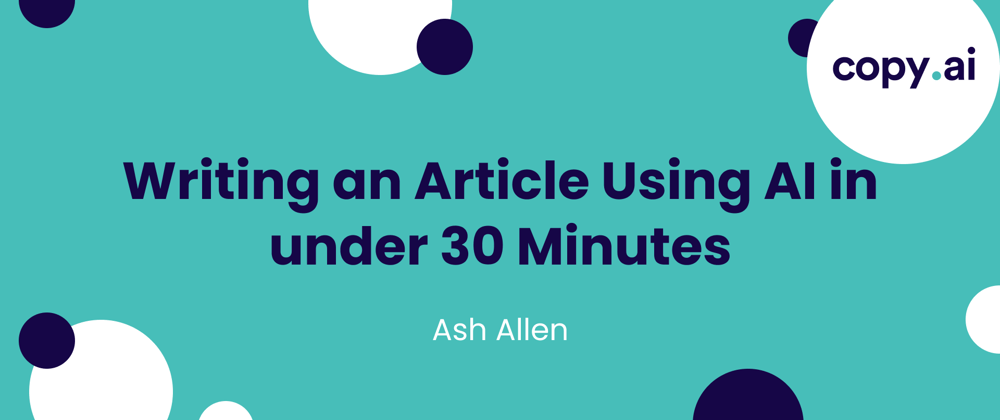Introduction
In June 2022, I published an article on my blog called "The Benefits of Contributing to Open Source Projects". This article was different from all my previous blog posts because I didn't actually write it myself. It was actually written (mostly) using an AI tool called CopyAI!
CopyAI is an AI-powered copywriter that can be used to generate content. They boast that you can generate high-quality blog posts in minutes (which is what I was testing). They offer features for email marketers to allow you to write high-converting emails in minutes. They also offer features for social media managers to help you create social media posts in minutes, including a Free Instagram Caption Generator (which seems to work really well!).
I used CopyAI as an experiment purely to find out how powerful AI writing tools can be. I'll be totally honest, I expected that the product would be a gimmick and that it would be obvious that the end result would have been written using AI. So, when I managed to have a full article written for my site (that looked like I'd written it myself) in under 30 minutes, I was amazed!
Since that article's been released, I've had several people ask me about my experience using CopyAI and how I felt about the article it wrote. So, I thought I'd put a short article together covering these points.
Writing the Article Using CopyAI
Before I cover how I managed to write the article, I want to state that I'm by no means clued up on AI. I don't really have any experience in understanding how it works at a technical level, but I do know that it surprised me how well the tool worked.
I started by heading over to CopyAI and registering for a free account.
I then navigated over to the "Blog Post Wizard" tool. This tool asked for 4 pieces of information to get started: the blog post title; keywords and phrases relevant to the blog post; the tone of the article; and goal of the article.
As an example, for the "The Benefits of Contributing to Open Source Projects" article, I provided the following data for the form:
- Blog post title - The Benefits of Contributing to Open Source Projects
- Keywords - The benefits of contributing to open source projects. Helping with getting a web developer job. Improving web development skills. Meeting new developers.
- Tone - Friendly
- Goal - Teaches the reader
After filling out the form, this generated the outline and "talking points" for the article. In this particular case, it generated some numbered items as part of a list.
Some of the numbered items were duplicates, so I removed them and then generated a few more talking points. I then proceeded to the next step of the process and it converted each of numbered items into fully-fledged paragraphs and text.
In theory, I could have taken the text that it had given me and published it. In my opinion, it read really well and if I didn't know any better, I wouldn't have known it was written using AI. In fact, I actually thought that it read very much like one of my own articles.
But, I took the AI-generated article and sprinkled some of my own writing into it. I just added an introduction, a conclusion, and put a couple of small sentences in to make the article personal to me (such as adding an example of how contributing to a specific project helped me to learn a new tool). After I added these pieces to the text, I hit the "Publish" button for the article.
All in all, I was really happy with the process of using CopyAI to write the article. I think it made the flow simple to understand and generated some content that I was genuinely surprised by. In fact, almost all of the talking points that it generated were the same as the talking points that I already had in my head about the subject.
However, I don't think that I would use the tool again for any of my own articles, or at least not at the same scale as I did for that article. The majority of my blog posts are heavily code-based, so CopyAI wouldn't be suited to writing those types of articles. But, I do think that it could serve as a pretty handy tool to help generate a sentence, or paragraph, when I get writer's block. So I wouldn't treat it as a tool for generating entire articles, but as more of an autocomplete tool, similar to how we might use GitHub Copilot or autocomplete in our IDE when writing code.
I am definitely interested to see how this technology evolves in the next few years!
Benefits of AI-written Articles
In general, I think that using an AI tool like CopyAI can have its benefits for someone like myself who likes to write in their spare time.
The benefits that I found were:
- Write content faster - It can usually take me several hours to write a new article. Although I might have an idea in my head about what I want to talk about, I've still got to translate my thoughts into words and sentences. By using CopyAI, I just needed to provide my thoughts in a few small bullet points and it wrote the content for me in seconds!
- Write content more efficiently - When I'm writing any articles (or even code), I make silly mistakes. These might be grammatical errors, typos, or missing out a few words (there might even be some in this article!). I do try and clean up my articles as much as I can before publishing, but sometimes mistakes do slip through. But, when I wrote the article with AI, the content was already written well and without any mistakes. This meant that I didn't need to spend as much time checking the content of the article for errors. As a result of this, it meant that I could move on to writing some more of my book (Battle Ready Laravel).
- Prevent "Writer's Block" - CopyAI has a cool feature that can convert a bullet point to a sentence or paragraph. I've found this particularly helpful as a way of preventing writer's block. Sometimes I get an idea of what I want to say but can't decide how to put it down in writing that makes sense. So I've found that it helps me along the way when I need a little bit of inspiration on what to write.
- Write good quality content if you're not a good writer - I genuinely believe that this tool could be useful for people who aren't good at writing. For example, it could be a great way for small or local businesses to generate some copy for their landing page. Or maybe some content to stick on their blog. Of course, I still think some manual intervention is needed in the writing, and this tool is definitely not a replacement for a professional copywriter, but I do think it could benefit companies when used right.
Drawbacks of AI-written Articles
Although I was (and still am) amazed at how well CopyAI worked, I do think that there are a few drawbacks to AI-written articles:
- Might be difficult to match the style and tone of the author - When I wrote my article, I was pleasantly surprised by how much the writing style matched my writing style. Like I mentioned above, if I didn't know any better, I'd have been convinced that I had actually written the content. However, this might not be the same for everyone else. You might have a different writing style that CopyAI can't replicate properly. If this is the case, I think it would look obvious that you had some content on your social media, website, blog, etc that you hadn't written.
- It can't write code - As I briefly mentioned earlier, I don't think I would be able to rely too heavily on using CopyAI because it doesn't write code. And, of course, I wouldn't expect it to be able to either! But because of this, it means that the tool probably doesn't provide as much value for me as it would for other writers who don't cover code-related topics. This isn't a drawback of the tool, but more that the style of my articles are different from the types of articles that CopyAI can generate.
- It can be disingenuous - I can't quite put my finger on why, but I feel like there might be something disingenuous about passing an article off as your own if it had been written using AI. I guess that it's no different from having an article written for you by a ghostwriter. I suppose that this is down to the medium where the writing is being posted though. If I went to an "expert's" blog to read about a specific topic, I would expect that the expert has taken their years of knowledge and written about it. So I might feel a little cheated if they had just used an AI tool to generate the entire article. Of course, if they've used it to write parts of the article, this is totally different and could be compared to using autocomplete or GitHub Copilot when writing code. This is just my opinion though, and I'm sure that it's an opinion that will likely change in the future.
- Can be penalized in Google search results - According to an article from Search Engine Land, Google penalizes content that it detects as being generated using AI tools. As a result of this, it can result in less traffic to your website!
Conclusion
Hopefully, this post should have given you an overview of how I wrote an article for my blog using CopyAI, and the possible benefits and drawbacks of using AI to write blog posts.
If you enjoyed reading this post, I'd love to hear about it. Likewise, if you have any feedback to improve the future ones, I'd also love to hear that too.
If you're interested in getting updated each time I publish a new post, feel free to sign up for my newsletter.
Keep on building awesome stuff! 🚀







Latest comments (0)